Bryston BDA-3.14 Renderer+DAC
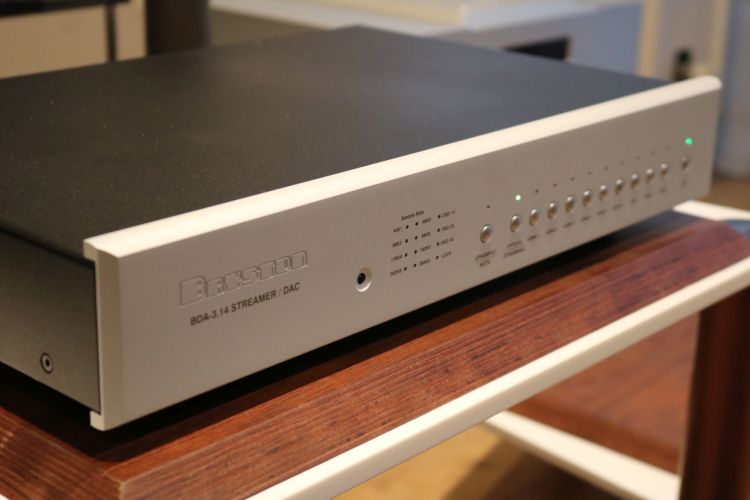
Review sample supplied by Mafico
Retail price (incl 21% VAT): 4.840 euro
RTFM. Yeah, but that doesn’t go for me, right? After fiddling with the BDA-3.14 for quite some time and getting no sound out of it using any of its inputs I was convinced that it was not functioning as it should. So, I reached out to the distributor via email, only to reluctantly pick up the manual while waiting for a response. Upon browsing it, I found the below A4 print…
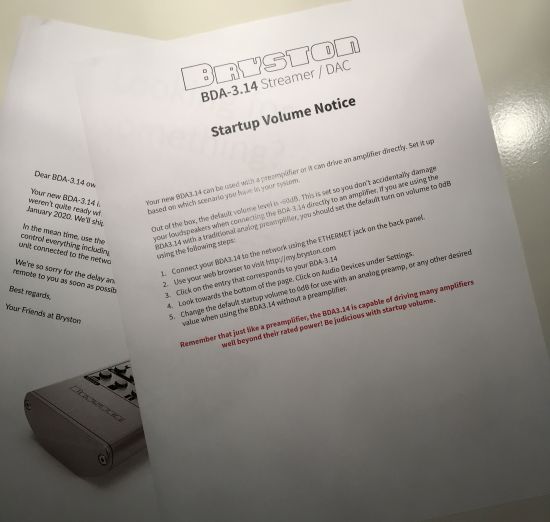
In my defense: the unit does not have volume control buttons nor any indication that it has volume control on its front panel. As I would later find out, the input buttons’ led indicators do function as volume indicators but only when it is changed, not permanently.
Its startup volume setting is around 50% and that’s attenuated enough to appear as silent with a regular volume setting on the CH preamp. After a restart, it returns to this setting even if it was raised before. This is a necessary safety feature that prevents heart attacks and damage to speakers but that nevertheless also always annoyed me when using any Wadia product. Fortunately, contrary to those Wadias, the BDA-3.14 allows the user to define the default startup level via its dashboard that is accessible via any web browser.
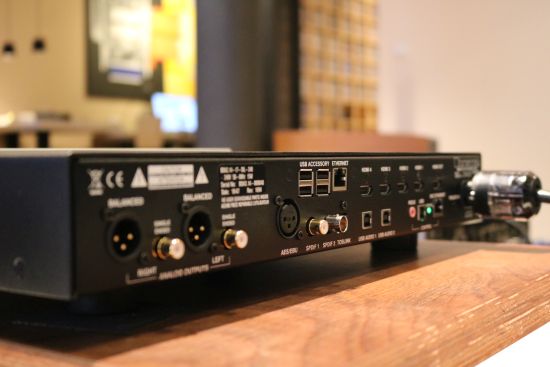
Functionality
The BDA-3.14 is Bryston’s current reference DAC and with its many inputs, streaming capacity and built-in volume control, it is meant to perform the central role in a multiple-digital-source system.
If I explain that the BDA-3.14 contains the BDA-3 DAC as well as the contents of the BDP-Pi, can you guess what inspired the model number? Indeed, it’s mathematical constant Pi! Containing the contents and functionality of these two boxes in one for only 430 euros more than the basic BDA-3 DAC is a very good offer. The streaming component is not just slapped on either but properly connected via I2S which is the best possible connection. The BDA-3.14 has an unprecedented amount of inputs among which are two USB ports (jay!), 4 HDMI ports, AES/EBU, SPDIF on coax, SPDIF on BNC, TOSLink and a network connection.

The built-in firmware has advanced a lot since the last time that I used a Bryston streamer and the current Manic Moose version looks modern, solid and intuitive while offering a wealth of configurable options. Accessible via any web browser on any network-enabled device by typing my.bryston.com, the user is able to access all of the front panel functions in addition to a very wide range of other functions, including volume control. Just like with Antipodes servers, the BDA-3.14 offers user-selectable compatibility with a range of playback methods such as MPD, RoonReady, Shairport-Sync, Squeezelite, DLNA/UPnP as well as access to a Samba share. The unit plays back PCM and DSD from the network as well as from USB thumb drives.
For its simplicity and stability, for many users, the built-in Bryston Media Player will be the interface of choice. While I found that it works intuitively, quickly and very well indeed, I’m afraid that I am intertwined too much with the Roon interface to much like any other interface anymore. Importantly, I found it is 100% stable also when using Roon. Besides local sources, the unit also offers an internet radio directory named bRadio and works with Tidal and Qobuz.
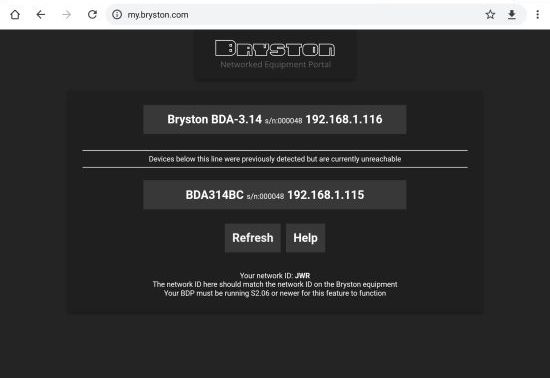
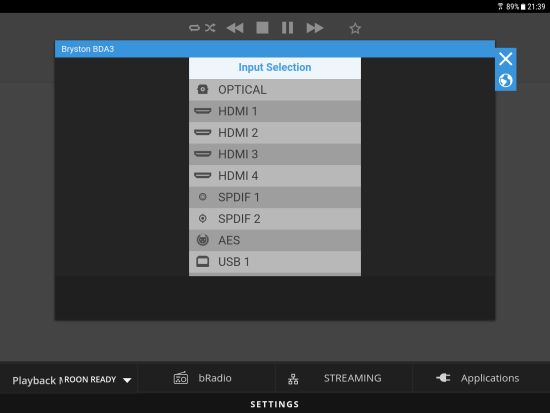
The manual also contained a leaflet that indicates that a nice remote control will be included later. As I noticed too late, the picture of that unit also contains volume up and volume down buttons. This is great for minimalistic systems that contain no analog sources but I still feel that the front panel should have an indication of the volume level for this to work on a level that I would be comfortable with. As I wanted to compare the BDA-3.14 to other DACs in a similar price class that do not have volume control I did not further investigate this possibility but I have no doubt that it will work well.
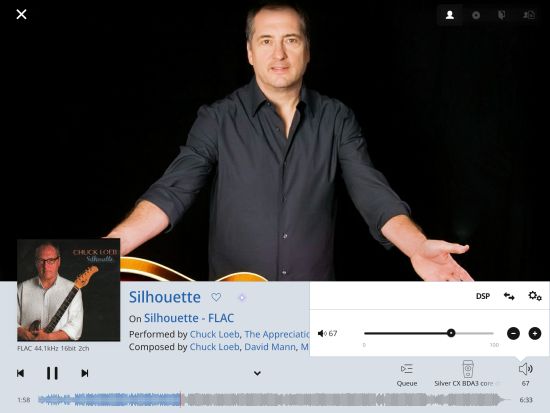
From Roon interface, the BDA-3.14’s volume level can be controlled directly
Bryston notes that the maximum output from the BDA3.14 RCA connectors is 2.0V and 4.0V on XLR balanced and that an amplifier with a gain of 29dB can generate 100 watts with only 1-volt input. The manual does not state how the volume leveling is implemented but I would assume it is done digitally. Now, some people might be hesitant with respect to digital volume leveling but I use a digital volume control with the CH Precision C1 myself every day and can honestly say that it is often a better solution than an analog level control.
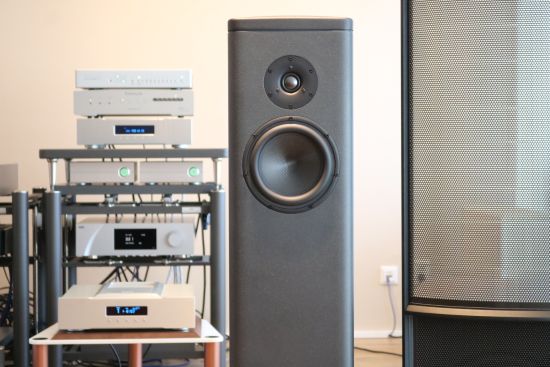
The DAC stack above was only for quick initial comparisons. The final judgments were made with each DAC sitting by itself directly on the Artesania platform.
Review Context
The BDA-3.14 will be assessed in a system comprised of the CH Precision L1 preamplifier and A1.5 power amplifier with Martin Logan ESL15A and Magico S1 MkII loudspeakers. The digital source, as always, is the Antipodes CX+EX music server. For further comparisons, I also have the Aqua Formula xHD, Jay’s Audio DAC-2 Signature and the Denafrips Venus DACs as well as the Jay’s Audio CDT-II MkII and Aqua La Diva CD transports at hand. The interlinks used are Vermouth Reference between the DACs and the preamplifier and CH Precision Balanced Link between preamp and power amp. Finally, the speaker cables are Jorma Design Trinity and the power cables all Belden with Bals schuko- and Oyaide C-004 IEC connectors.
The BDA-3.14 was a demo model that had already seen use but I also allowed it plenty of time to come on song. That was more as a “just in case” than a necessity as I don’t feel that Bryston products need much if any warming up.
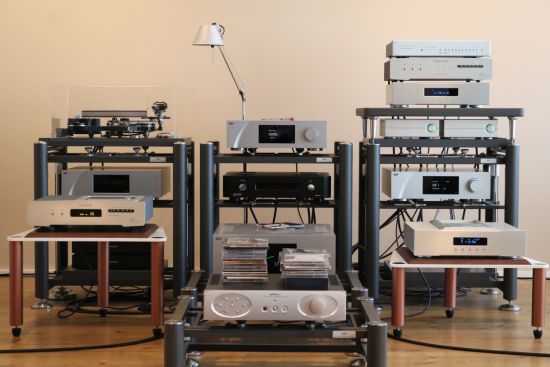
Listening
I started my listening to the Bryston BDA-3.14 after a long day at work without any prior comparisons. Connected at this time were the Magicos with the Aqua La Diva CD transport as a source. That’s because I am currently in a kind of CD-mood and as a result am comparing various CD spinners.
Anyway, the BDA-3.14 sounded really great! There was absolutely nothing standing out that I could pick at and nothing obviously missing and it all seemed just perfectly proportioned. There was great resolution, perfectly natural timbre (no artifice) an overall solid sound with lively dynamics and without any hardness or edge. Along with the propulsive liveliness, there was also a subtle smoothness and fluidity that prevented the sound ever becoming dry. And, as I have found out during earlier Bryston tests, if a product sounds fluid and smooth with the Magicos, then you can certainly trust that this really is the case. Now, certain products achieve a forgiving sound by sounding overly smooth but with the BDA-3.14 this is absolutely not the case. It is slightly smooth but also propulsive and lively.
Now it was time to switch to the Antipodes CX+EX music server with the aim to compare USB sound to Streaming sound, as well as to make a generic comparison between the Music Server and the CD transport. After having set the BDA-3.14 to RoonReady in the dashboard (it was in UPnP mode when I got it), the device was found by Roon immediately. Starting with the EX as the renderer, connected to the BDA-3.14 via Final Touch Audio Callisto USB cable, the sound was even more sonorous and spacious but less articulate and less spritely. The sound was still dynamic but more static than with the CD transport. This has nothing to do with the BDA-3.14, though, it is a difference that I have noticed with any DAC. The Aqua transport is just that spritely.
Switching the USB cable from the EX to the CX so that the server and renderer are on the same device makes for a more nimble and articulate sound closer to that of the La Diva but I’m not sure if I prefer this leaner sound to the room-filling fullness of the EX. For more in-depth descriptions of these options please refer to the Antipodes review.
Streaming input
When bypassing the EX and CX’s renderer function and the USB cable and using the CX as a server only (just as I do with the CH Precision C1’s RoonReady ethernet input board) the BDA-3.14 all of a sudden strongly reminded me of the Bryston BDP-3 media player. Now, the sound was very close to that of the La Diva transport. Tighter, nimbler and more articulate as well as more direct, the Aqua transport remains the most energetic source but there is also a lot to say for the server sound. It seems that the physically more direct connection really also results in better sound. It’s always good to have lots of options, especially when talking about digital inputs. As the CD transports clearly illustrates, the DAC portion of the BDA-3.14 is really great. But especially when compared to the Antipodes server, it’s with its built-in streamer section that the BDA-3.14 is most impressive.
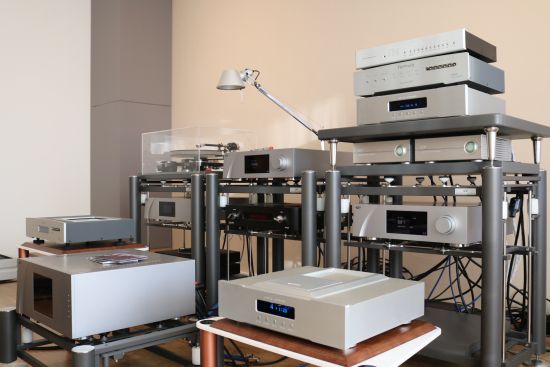
Speaking of options, I also have the 2500-Euro Jay’s Audio CDT-II MkII CD transport (top right) which is really interesting because unlike the La Diva and any other transport still available that I am aware of, it uses the famous Philips CDM4 swing-arm mechanism. This mechanism has a unique sound and the Jay’s player proper implementation of it results in a sound that is very fluid and utterly free-flowing combined with a big and rich bass. In terms of the latter, the Jay’s CD transport has a sound that is closer to the Antipodes EX sound and less similar to the La Diva transport. In practice, when choosing between these two CD transports, this means that the user has a choice for a fuller, more relaxed and more free-flowing sound or a more urgent and more spritely sound. The former is more forgiving, the latter less so. The Aqua is more audiophile to a level where I even prefer it to the music server but at almost 8000 Euros it is also considerably more expensive than the Jay’s. In any event, the BDA-3.14 clearly demonstrates the differences between these sources meaning that there is nothing wrong with its transparency.
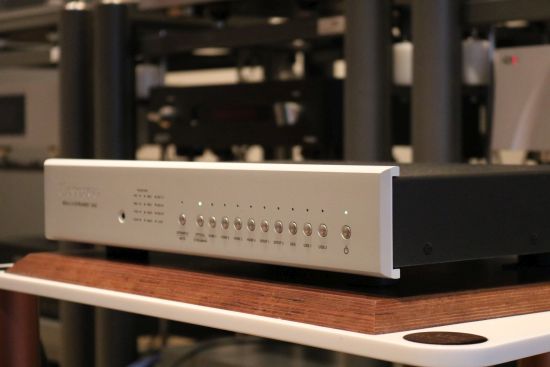
Yes, there are more transparent DACs. The Aqua Formula xHD and the Denafrips Venus are both more highly resolving and more transparent. Both DACs use a discrete NOS R2R topology which gives them a cleaner, higher-res and more direct sound than most other DAC topologies. On an absolute scale, I would say that both these components offer more insight into the recordings and as such can be considered to be more high-end than the Bryston. In the case of the Aqua, there is no shame in that because the Formula xHD costs 13.670 euros. In the case of the Denafrips, the situation is more competitive as the Venus is more or less in the same price range as the Bryston. But here it becomes a matter of choosing between a pure DAC with more audiophile sound and a DAC that includes a ridiculously good sounding streaming endpoint as well as the largest selection of inputs that I have seen on a DAC yet. While both the Aqua and Denafrips DACs are more transparent and refined, as I mentioned at the start of this review, this is only evident upon comparison and that makes it a little bit more relative.
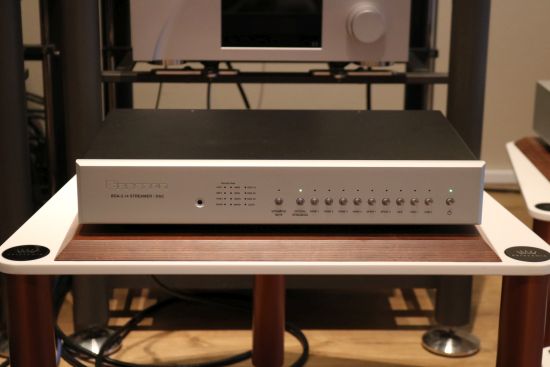
The Jay’s Audio DAC-2 Signature, finally, also offers a very interesting perspective. At 3000 euro, it costs less than the Bryston so the question begs: how does it compare? As I already noticed during the Jay’s review, the DAC has an unusually solid and chunky sound, reminiscent of the classic Wadia DACs. When compared with the Bryston BDA-3.14, itself certainly not feeble or thin sounding, this still remains so. The Jay’s has an appealingly lifelike midrange that makes for a very communicative sound and in comparison, the Bryston is smoother and even a little creamy through the mid-bass and lower midrange. While the other DACs confirm that the Bryston is slightly on the smooth side of neutral it is also true that the Jay’s is a little dry, just like the classic Wadias. Its dry treble goes hand in hand with more articulate bass and so this is a benefit as well as a potential pitfall. But this also makes that the Jay’s DAC works so very synergistically with the Jay’s transport. With the Martin Logans, I find that all the DACs have their perks and none of them have any obvious flaws. With the Magicos, however, it became clear that the Bryston DAC has slightly better resolution and a wider soundstage than the Jay’s.
Conclusion
Clearly, the BDA-3.14 is a great DAC with a truly excellent streamer section on board. The latter is not just slapped on but implemented so well that it improves even on the Antipodes CX+EX music server. When used as a standalone DAC using its SP/DIF input with any source, it holds up strong, even in comparison with much more expensive DACs. The BDA-3.14 has a solid and immediately likable sound with great resolution, perfect natural timbre (no artifice) and lively dynamics and without any hardness or edge. Along with the propulsive liveliness, it also has a subtle smoothness and fluidity that makes the end result revealing yet forgiving.

Videos on the Hifi-Advice YouTube Channel
How Sooloos became Roon
HFA Front Page
Try out Roon for yourself
External Links
Distributor for the Benelux: Mafico

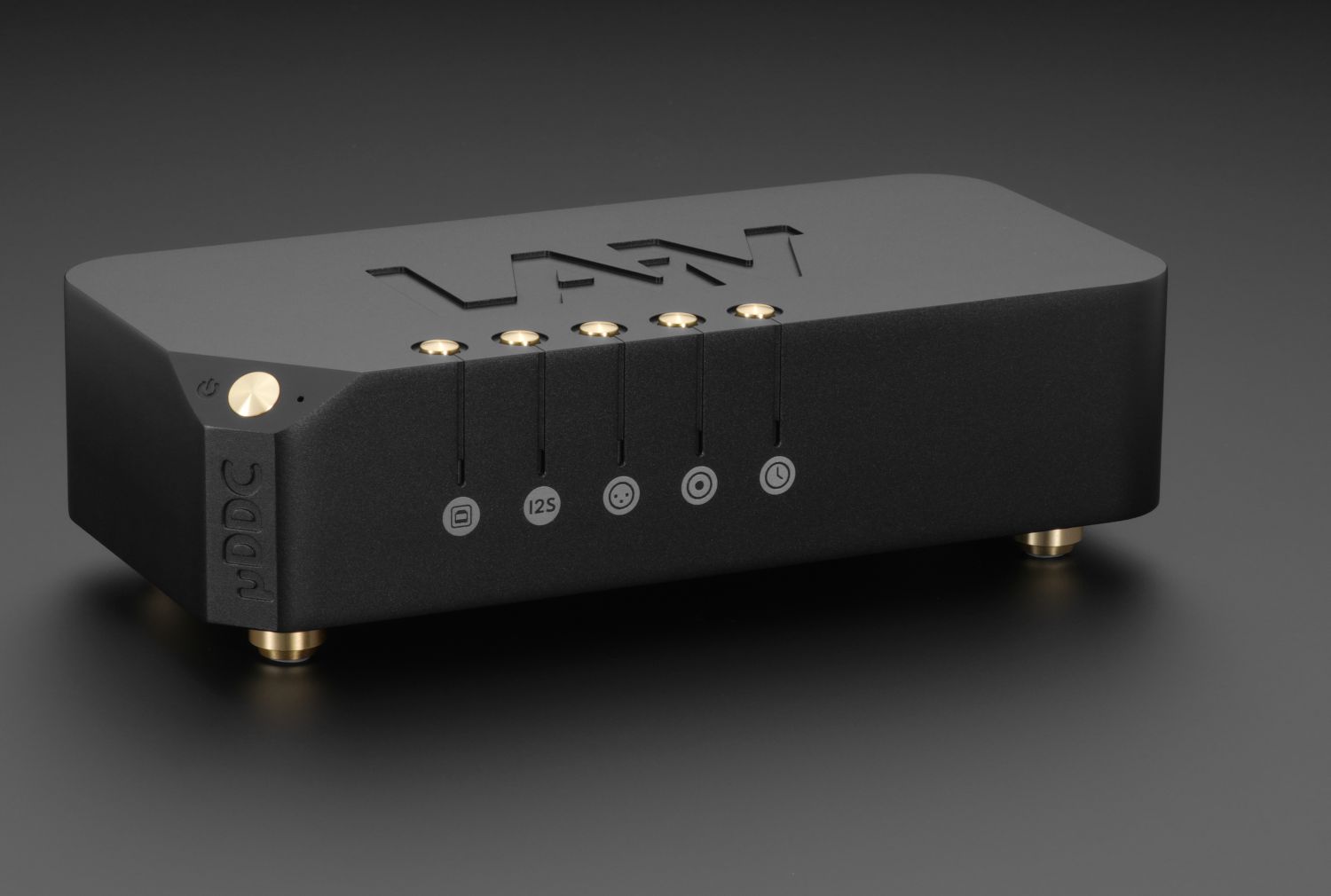
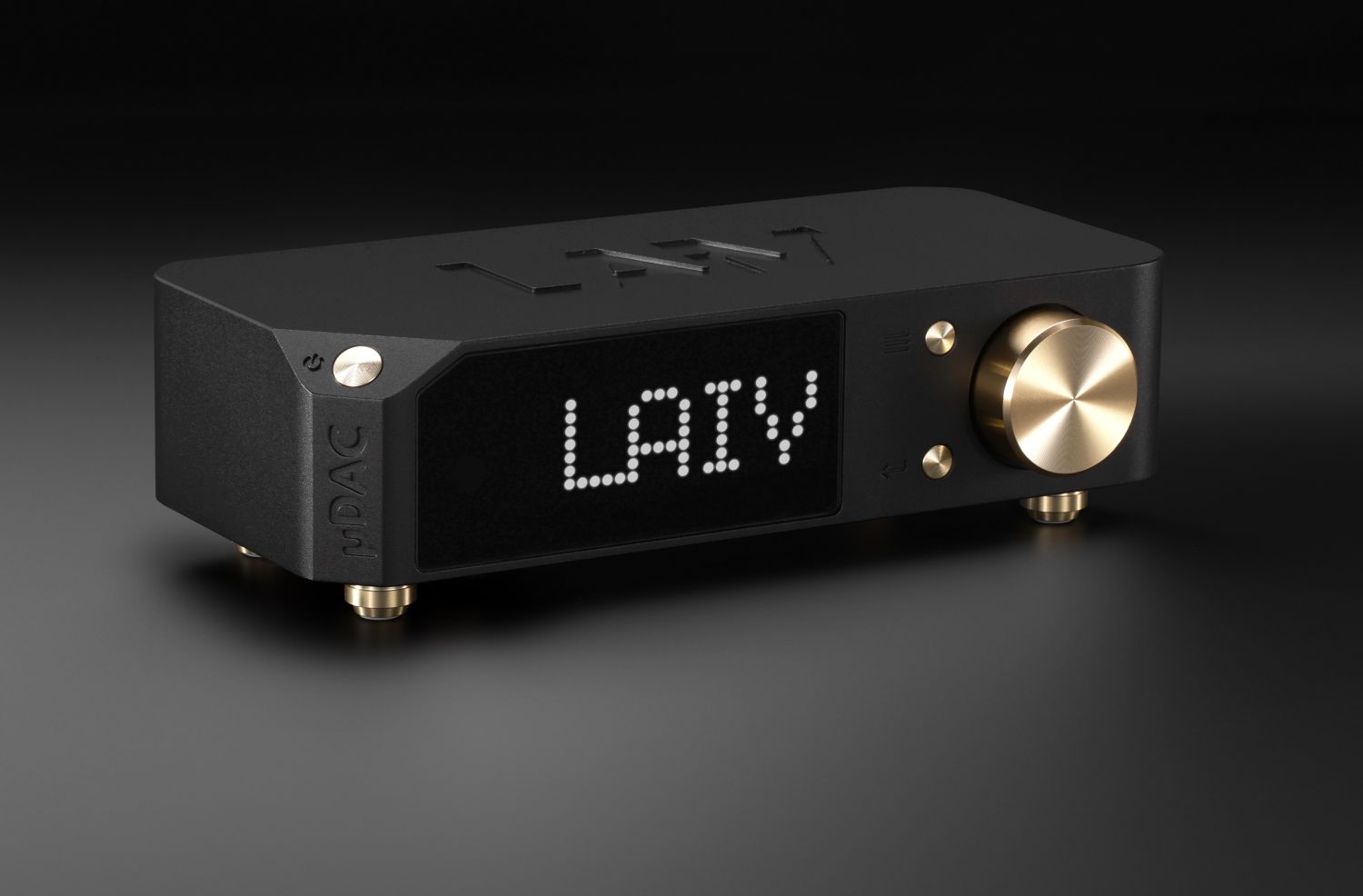
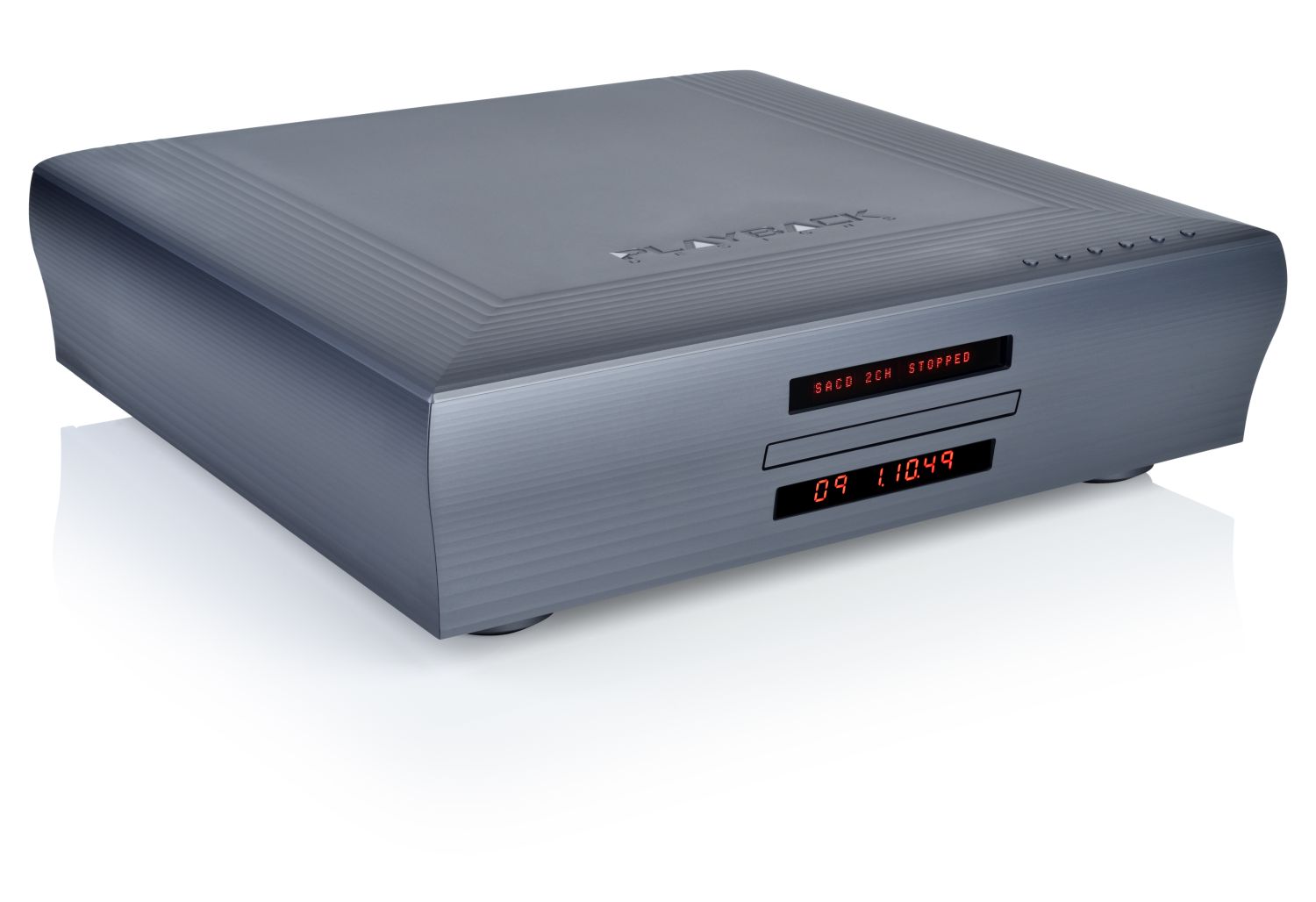




Hi, I enjoyed your review. I actually read it a few times before deciding to purchase the Bryston BDA-3.14. Just wanted to clarify what you sstated about there not being a volume level indication on the front panel. The following is an excerpt from page 11 in the manual:
“8. Input LED Indicators
While these normally indicate which input is
selected (Green when signal is present, Red
when no signal is present), the 10 input LEDs
can also act as a volume control scale while
the volume is being adjusted. The BDA-3.14 is
calibrated so that the top 30dB of the volume
range is represented by the scale. While the
volume is being adjusted up the LEDs will
begin progressively lightning yellow from left to
right to indicate that the volume is rising. The
opposite is true while volume is actively being
decreased.”
Cheers!
Hi Bill, yes, I found that out later. RTFM, right?! What I meant is that there are no volume buttons nor an indication that it has volume control. I forgot to add this to the text but did now:-)
Hi Christiaan, yes, sometimes not reading the whole manual will come back to bite you. Lol. Thanks for making the edit, future readers on the review will appreciate it, I’m sure. I have placed my order and am now anxiously awaiting the arrival of my new BDA-3.14. Cheers.
An interesting question is how does the 3.14 compare with the BDA-3 and the BDP-3 together?
I am having such a time of it trying to decide what components I need to build a decent system where I wish to access CD and digital files/streaming.
Cheers, Mark
Good question indeed. Alas, I never had them side by side for a direct comparison, but based on the info that was supplied to me as well as on the listening that I did to both, I have a strong feeling that there is not much between the two. I would go for the integrated 3.14 and perhaps spring for a BCD3 CD player or if you are on a tighter budget, perhaps look at the very affordable StreamUnlimited Blue Tiger mechanism-equipped Pro-Ject CD Box RS transport or the CD-8-equipped Pro-Ject CD Box RS2 T and use these with the 3.14 DAC section.
Thank you, Mr Punter – My thinking was indeed directed to pairing up a Bryston DAC and its BCD3, so your suggestions are very helpful. I will look at the Pro-Ject CD units, too. Always keep an open mind.
Now, on to identifying an appropriate integrated amp and I should be set to replace my, sadly, dying Linn Classik.
I was keenly interested in this review, been looking to combine a preamp/DAC with streamer. Bryston came to mind, as I own their 4b3 thanks to your review on it last year.
As always, your reviews don’t disappoint. But, I don’t think I’m gonna jump on the 3.14. Im sure you’ve known for a few months, a new model (BR-20) is about to hit the street. Looks superior and more complete in every way. Any chance you’ll be getting your hands on one to review soon???
Nice to hear my reviews have been of help. Indeed I know that the BR-20 will come out soon and I may do a review but nothing has been planned as of yet. The BR-20 is an actual analog preamp while the 3.14 is a DAC with digital volume control, meaning that they shouldn’t be directly compared. That said, as I understand it, the BR-20 will indeed be a superb preamp and as such, should be compared to other pure analog preamps.
Christiaan, true the BR-20 has added the analogue side, though the Bryston write up on it says it’s got the same BDA-3 DAC used in the 3.14 as well. So you could attempt a sound comparison on the grounds they have the same digital side.
“ We combined the excellent BDA-3 DAC with an updated BDP streaming platform into the system so you can get the best possible digital performance from our built in player, or the digital source of your choosing.”
Guess I’m just saying I’m a fan comparisons… in this case, I could more accurately see if waiting for the BR-20 was worth it over the 3.14.
Christiaan,
The BR-20 has been shipping, they aren’t keeping up with demand, heard they are 6 months out on fulfilling orders at current rates. I nominate you to get one sooner rather than later… Also read some early opinions, “award winner” captures them best.
Hi Marc, I’m aware… 😉 No date has been set yet but there’s a good chance that I will be doing a review in the near future.
“ there’s a good chance that I will be doing a review in the near future.”
Fantastic!
Hi Christiaan,
Any update on when you might get your hands on a Bryston BR-20?
Hi Marc, the distributor tells me that they are in short supply and that every component in each shipment is basically sold before it can be shelved. A review is still planned but the timing remains uncertain.
If I find one, I’ll ship it to you. ; )
Seriously though. I do love the idea of the BR-20, everything in one, even an HDMI pass through.
But, while waiting for you to get your hands on one, I’ve been investigating your recommendation of just getting a good DAC with volume control. Since all my sources are digital, it makes sense.
That said, wanting to maximize sound quality and bang for buck….that review of the Denafrips terminator plus sounds perfect, except no volume. Any recommendations on a completely, absolutely neutral pre to act as nothing but volume control??
Indeed, that’s the one thing on my wishlist for the Terminator… But digital volume control would go against the purity of the system as it will require the kind of processing (up/resampling) that they consciously avoid with the use of NOS, filterless, discrete R2R conversion. And analog volume control is not easy to implement well. Oh well…
Yeah, that’s the million-dollar question. I am on the same quest and it’s why I still prefer to use the CH C1 DAC directly with the power amp.
That said, the Audio-GD Master 1 comes closer than most and at a ridiculously low price. If you haven’t read it yet, see my review and by all means, do try to get your hands on one to hear for yourself. Oh, and Denafrips also has a preamp. No idea how it will perform but it might be an idea.
Great review, as usual!
Does a machine like the Lejonklou Källa sound very different from this Bryston? In particular, do you think there is a big difference in the quietness of operation? (which impressed me a lot on the Källa)
Yes, very, very different. Kalla is leaner, airier, floatier, gentler, more refined. BDA is more solid and grounded, more bold, fuller in tonality, and richer/creamier/fatter. Not sure what you mean with quietness of operation. Neither device made any mechanical noises.
Thank you very much Christiaan. The differences between the two devices are very clear with your words.
About quietness (I had used the term “silence”), it’s not so easy to express, even less through a translator like Google or Deepl…
How to express what silence is? Perhaps this impression that each sound is like a perfectly clean and white line, which stands out on a black background? Some electronics give this impression more than others (and it is not only transparency). I think this is one of the great strengths of Källa.
I’d say that the two are equally good at expressing cleanness, silence, or blacks. Certainly the streamer part of the Bryston (that is also available independently and also reviewed on this site) I would rate on par in that regard as well as on many other facets. It’s mostly the DAC that’s built into the Bryston that makes a large difference, adding fullness, smoothness, etc.
Thank you Christiaan. I really appreciate the attention you give to these questions and the accuracy of your answers.
Hello Christiaan, wil this Bryston spenderen beter than a Aurender A10?
regards Albert van Bentem.
Difficult to say as I have not heard the A10. That said, based on the models I did hear, the two have a different house sound. The Bryston more direct and expressive and the Aurender more polished and gentlemanlike.
Hi Christiaan,
do you think the 3.14 can be used with a Melco N1ZH/2 for example connected via ethernet? I understood that you prefer this connection over USB, thanks.
P.S. Otherwise do you know some good dacs (less pricey than the Ch Precision) that have this input? thanks!!
Hi David, Indeed, my preference for streaming interfaces tends to be UPnP, but it can depend on the implementation. Bryston has a long history with UPnP, sounds very good that way, and the BDA-3.14 is indeed compatible. (a quick internet search reveals: “The Bryston BDA-3.14 offers a whole range of directly selectable protocols for network functionality such as MPD, RoonReady, Shairport-Sync, Squeezelite, DLNA / UPnP and access to a Samba share”).
One example of a more affordable network-DAC is the Wattson Madison/Madison LE that I reviewed very recently. There should be more, though. To find network-compatible DACs, just add “network” or “UPnP” to your Google search term.